Leadership and Management Roles at John Lewis: A Detailed Analysis
VerifiedAdded on 2023/01/13
|7
|1741
|72
Report
AI Summary
This report delves into the critical aspects of leadership and management within the context of operations management, using John Lewis as a case study. It begins by defining and comparing the distinct roles and characteristics of leaders and managers, highlighting their responsibilities in driving organizational success. The report then explores the practical application of leadership and management theories, such as transformational leadership and classical management theory, within the company. It analyzes how these theories contribute to effective management practices and the achievement of organizational goals. The analysis includes the roles of encouragement, setting mission and vision, positive attitude, ability to face challenges, communication, and delegation. The report also provides a comparative analysis between leaders and managers in terms of risk-taking, style, and approach. The conclusion emphasizes the significance of sound operations management, effective leadership, and the collaborative efforts of leaders and managers in fostering a productive and successful work environment. This report provides valuable insights for students studying leadership and management, and is available on Desklib, a platform offering past papers and solved assignments.
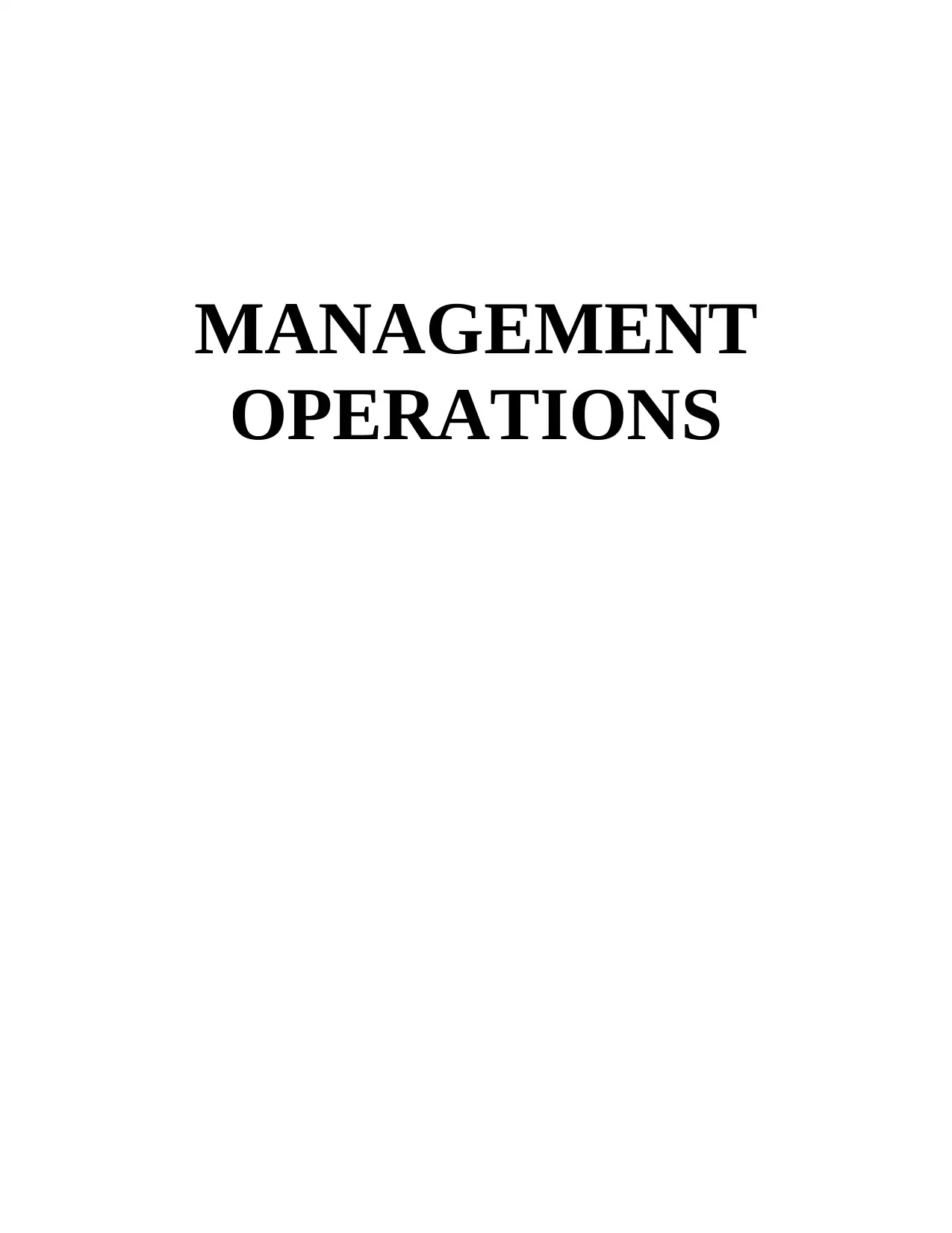
MANAGEMENT
OPERATIONS
OPERATIONS
Paraphrase This Document
Need a fresh take? Get an instant paraphrase of this document with our AI Paraphraser
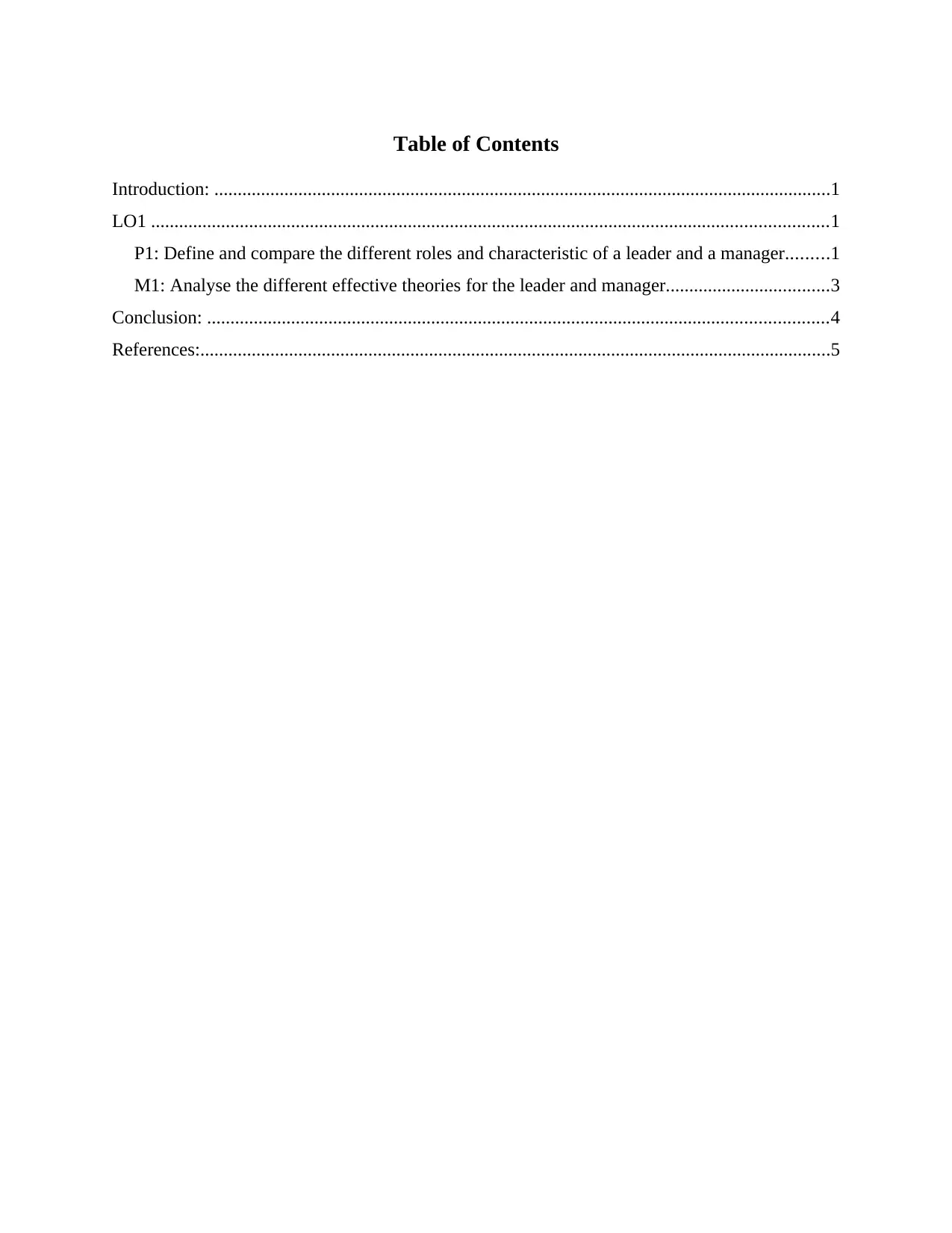
Table of Contents
Introduction: ....................................................................................................................................1
LO1 .................................................................................................................................................1
P1: Define and compare the different roles and characteristic of a leader and a manager.........1
M1: Analyse the different effective theories for the leader and manager...................................3
Conclusion: .....................................................................................................................................4
References:.......................................................................................................................................5
Introduction: ....................................................................................................................................1
LO1 .................................................................................................................................................1
P1: Define and compare the different roles and characteristic of a leader and a manager.........1
M1: Analyse the different effective theories for the leader and manager...................................3
Conclusion: .....................................................................................................................................4
References:.......................................................................................................................................5
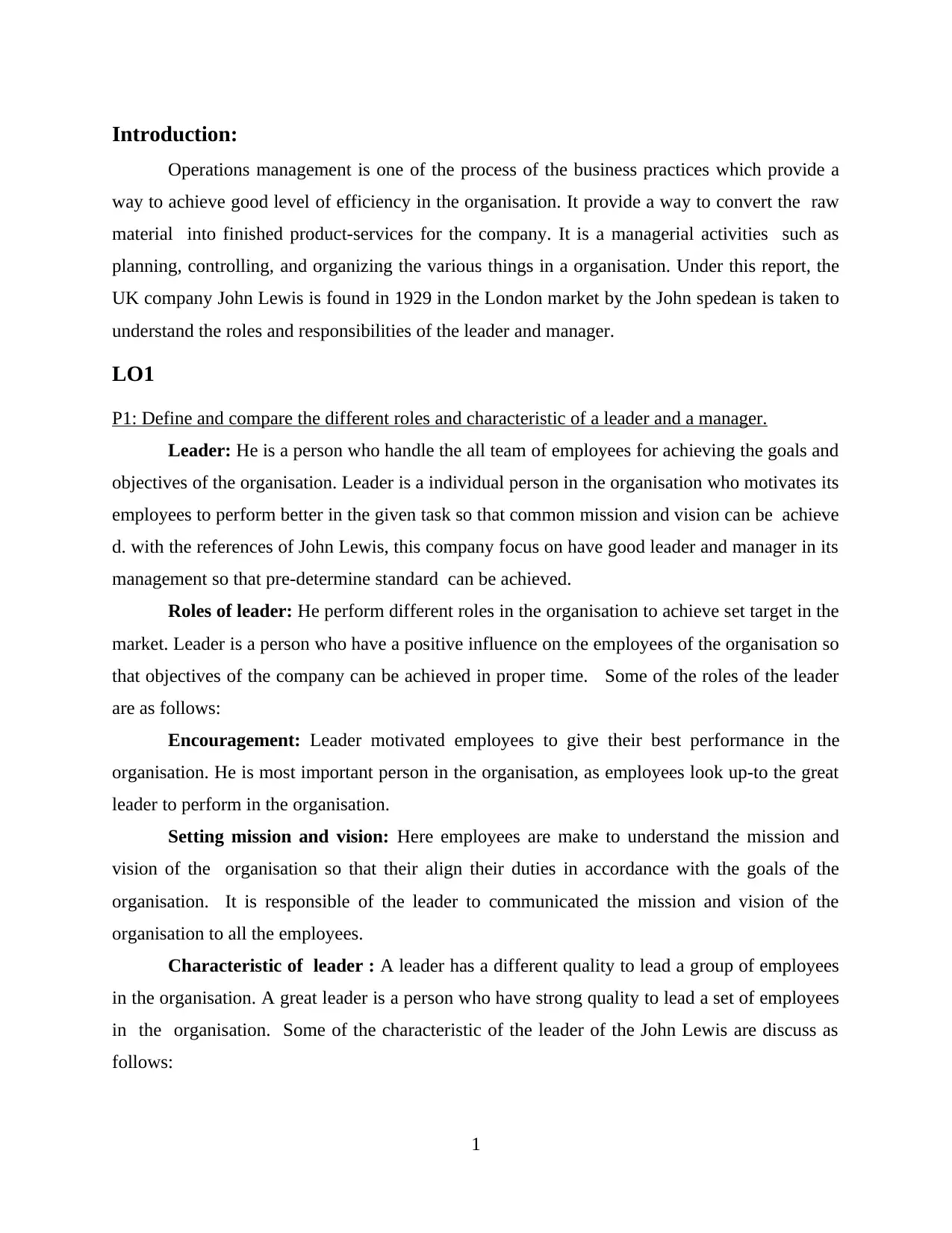
Introduction:
Operations management is one of the process of the business practices which provide a
way to achieve good level of efficiency in the organisation. It provide a way to convert the raw
material into finished product-services for the company. It is a managerial activities such as
planning, controlling, and organizing the various things in a organisation. Under this report, the
UK company John Lewis is found in 1929 in the London market by the John spedean is taken to
understand the roles and responsibilities of the leader and manager.
LO1
P1: Define and compare the different roles and characteristic of a leader and a manager.
Leader: He is a person who handle the all team of employees for achieving the goals and
objectives of the organisation. Leader is a individual person in the organisation who motivates its
employees to perform better in the given task so that common mission and vision can be achieve
d. with the references of John Lewis, this company focus on have good leader and manager in its
management so that pre-determine standard can be achieved.
Roles of leader: He perform different roles in the organisation to achieve set target in the
market. Leader is a person who have a positive influence on the employees of the organisation so
that objectives of the company can be achieved in proper time. Some of the roles of the leader
are as follows:
Encouragement: Leader motivated employees to give their best performance in the
organisation. He is most important person in the organisation, as employees look up-to the great
leader to perform in the organisation.
Setting mission and vision: Here employees are make to understand the mission and
vision of the organisation so that their align their duties in accordance with the goals of the
organisation. It is responsible of the leader to communicated the mission and vision of the
organisation to all the employees.
Characteristic of leader : A leader has a different quality to lead a group of employees
in the organisation. A great leader is a person who have strong quality to lead a set of employees
in the organisation. Some of the characteristic of the leader of the John Lewis are discuss as
follows:
1
Operations management is one of the process of the business practices which provide a
way to achieve good level of efficiency in the organisation. It provide a way to convert the raw
material into finished product-services for the company. It is a managerial activities such as
planning, controlling, and organizing the various things in a organisation. Under this report, the
UK company John Lewis is found in 1929 in the London market by the John spedean is taken to
understand the roles and responsibilities of the leader and manager.
LO1
P1: Define and compare the different roles and characteristic of a leader and a manager.
Leader: He is a person who handle the all team of employees for achieving the goals and
objectives of the organisation. Leader is a individual person in the organisation who motivates its
employees to perform better in the given task so that common mission and vision can be achieve
d. with the references of John Lewis, this company focus on have good leader and manager in its
management so that pre-determine standard can be achieved.
Roles of leader: He perform different roles in the organisation to achieve set target in the
market. Leader is a person who have a positive influence on the employees of the organisation so
that objectives of the company can be achieved in proper time. Some of the roles of the leader
are as follows:
Encouragement: Leader motivated employees to give their best performance in the
organisation. He is most important person in the organisation, as employees look up-to the great
leader to perform in the organisation.
Setting mission and vision: Here employees are make to understand the mission and
vision of the organisation so that their align their duties in accordance with the goals of the
organisation. It is responsible of the leader to communicated the mission and vision of the
organisation to all the employees.
Characteristic of leader : A leader has a different quality to lead a group of employees
in the organisation. A great leader is a person who have strong quality to lead a set of employees
in the organisation. Some of the characteristic of the leader of the John Lewis are discuss as
follows:
1
⊘ This is a preview!⊘
Do you want full access?
Subscribe today to unlock all pages.

Trusted by 1+ million students worldwide
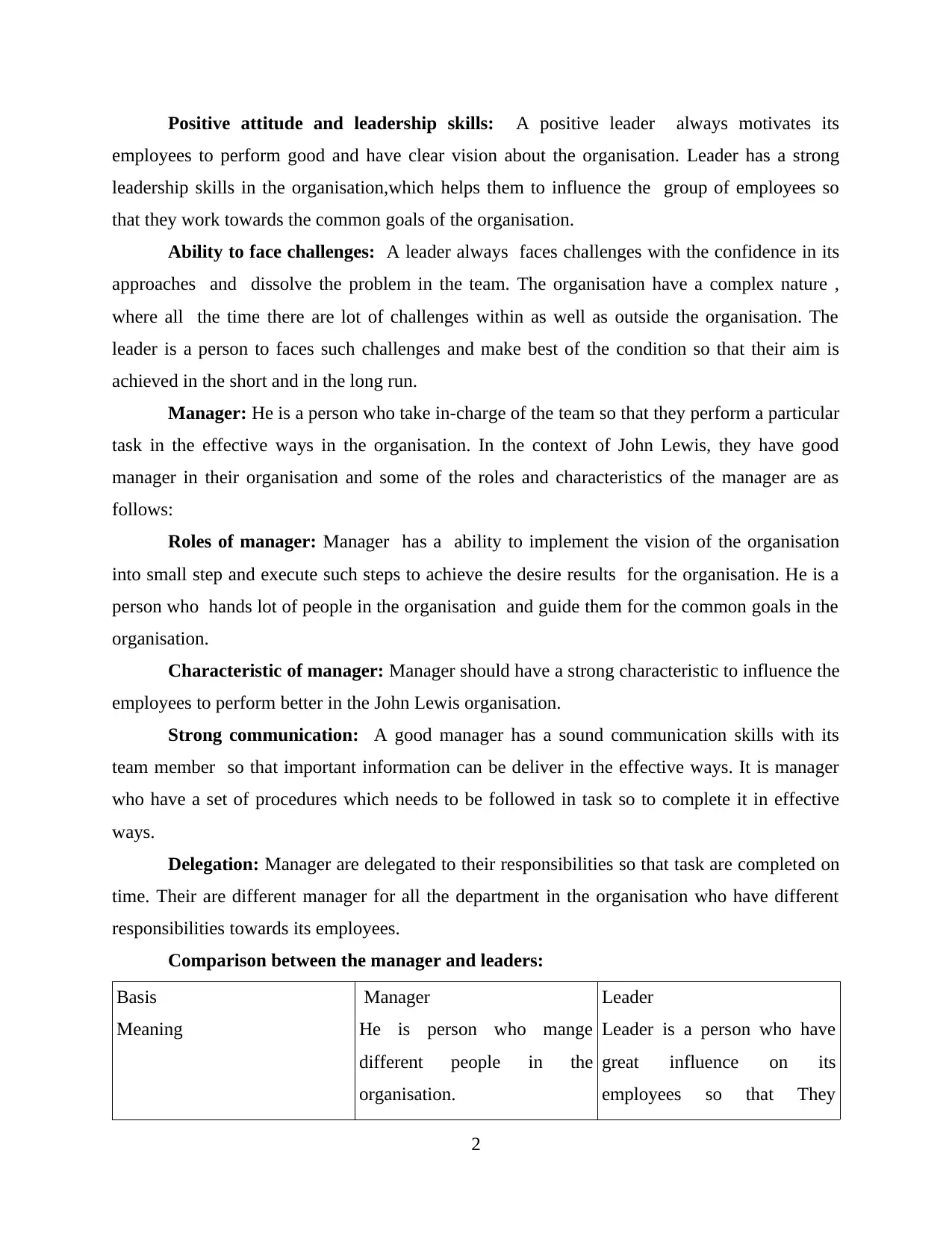
Positive attitude and leadership skills: A positive leader always motivates its
employees to perform good and have clear vision about the organisation. Leader has a strong
leadership skills in the organisation,which helps them to influence the group of employees so
that they work towards the common goals of the organisation.
Ability to face challenges: A leader always faces challenges with the confidence in its
approaches and dissolve the problem in the team. The organisation have a complex nature ,
where all the time there are lot of challenges within as well as outside the organisation. The
leader is a person to faces such challenges and make best of the condition so that their aim is
achieved in the short and in the long run.
Manager: He is a person who take in-charge of the team so that they perform a particular
task in the effective ways in the organisation. In the context of John Lewis, they have good
manager in their organisation and some of the roles and characteristics of the manager are as
follows:
Roles of manager: Manager has a ability to implement the vision of the organisation
into small step and execute such steps to achieve the desire results for the organisation. He is a
person who hands lot of people in the organisation and guide them for the common goals in the
organisation.
Characteristic of manager: Manager should have a strong characteristic to influence the
employees to perform better in the John Lewis organisation.
Strong communication: A good manager has a sound communication skills with its
team member so that important information can be deliver in the effective ways. It is manager
who have a set of procedures which needs to be followed in task so to complete it in effective
ways.
Delegation: Manager are delegated to their responsibilities so that task are completed on
time. Their are different manager for all the department in the organisation who have different
responsibilities towards its employees.
Comparison between the manager and leaders:
Basis
Meaning
Manager
He is person who mange
different people in the
organisation.
Leader
Leader is a person who have
great influence on its
employees so that They
2
employees to perform good and have clear vision about the organisation. Leader has a strong
leadership skills in the organisation,which helps them to influence the group of employees so
that they work towards the common goals of the organisation.
Ability to face challenges: A leader always faces challenges with the confidence in its
approaches and dissolve the problem in the team. The organisation have a complex nature ,
where all the time there are lot of challenges within as well as outside the organisation. The
leader is a person to faces such challenges and make best of the condition so that their aim is
achieved in the short and in the long run.
Manager: He is a person who take in-charge of the team so that they perform a particular
task in the effective ways in the organisation. In the context of John Lewis, they have good
manager in their organisation and some of the roles and characteristics of the manager are as
follows:
Roles of manager: Manager has a ability to implement the vision of the organisation
into small step and execute such steps to achieve the desire results for the organisation. He is a
person who hands lot of people in the organisation and guide them for the common goals in the
organisation.
Characteristic of manager: Manager should have a strong characteristic to influence the
employees to perform better in the John Lewis organisation.
Strong communication: A good manager has a sound communication skills with its
team member so that important information can be deliver in the effective ways. It is manager
who have a set of procedures which needs to be followed in task so to complete it in effective
ways.
Delegation: Manager are delegated to their responsibilities so that task are completed on
time. Their are different manager for all the department in the organisation who have different
responsibilities towards its employees.
Comparison between the manager and leaders:
Basis
Meaning
Manager
He is person who mange
different people in the
organisation.
Leader
Leader is a person who have
great influence on its
employees so that They
2
Paraphrase This Document
Need a fresh take? Get an instant paraphrase of this document with our AI Paraphraser
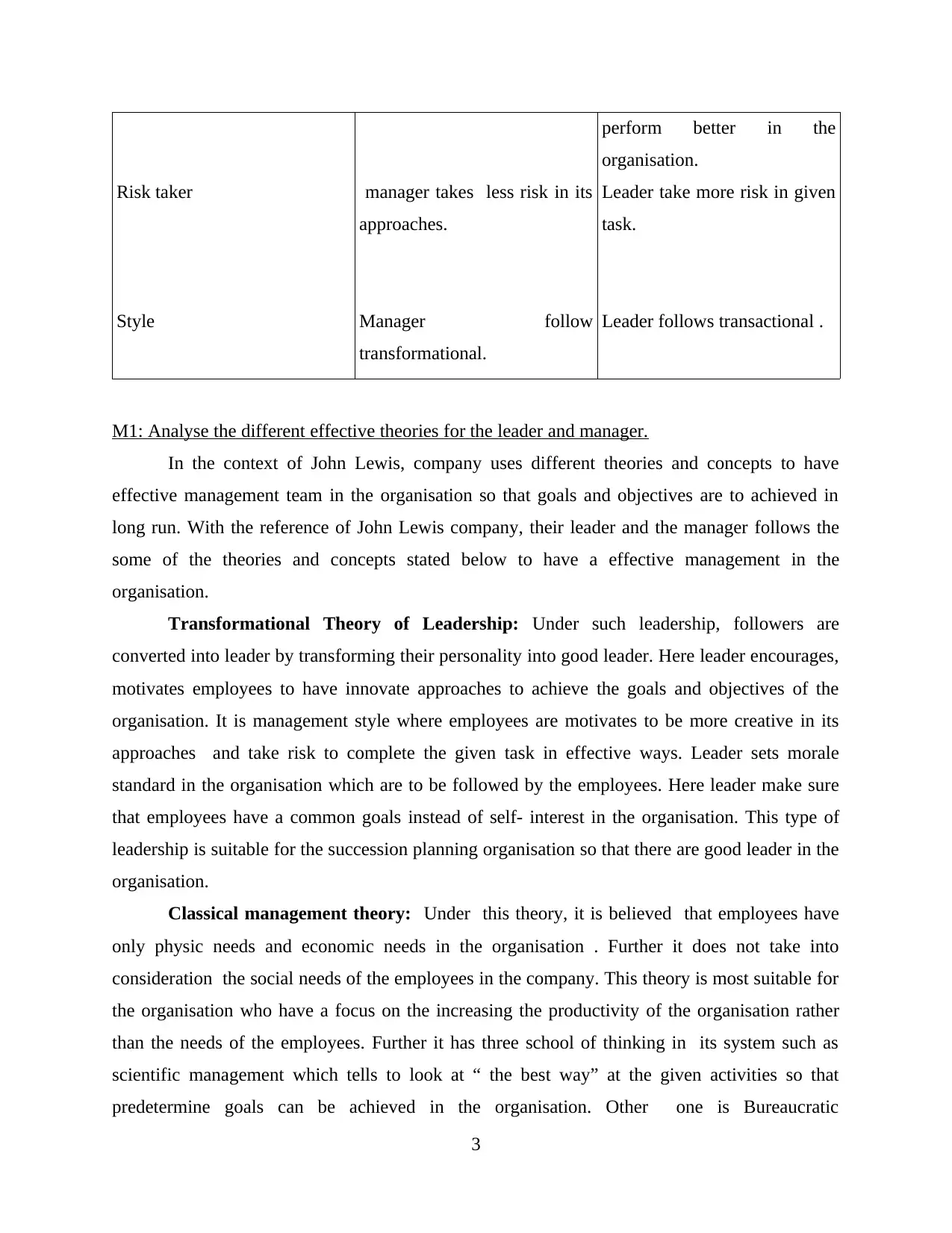
Risk taker
Style
manager takes less risk in its
approaches.
Manager follow
transformational.
perform better in the
organisation.
Leader take more risk in given
task.
Leader follows transactional .
M1: Analyse the different effective theories for the leader and manager.
In the context of John Lewis, company uses different theories and concepts to have
effective management team in the organisation so that goals and objectives are to achieved in
long run. With the reference of John Lewis company, their leader and the manager follows the
some of the theories and concepts stated below to have a effective management in the
organisation.
Transformational Theory of Leadership: Under such leadership, followers are
converted into leader by transforming their personality into good leader. Here leader encourages,
motivates employees to have innovate approaches to achieve the goals and objectives of the
organisation. It is management style where employees are motivates to be more creative in its
approaches and take risk to complete the given task in effective ways. Leader sets morale
standard in the organisation which are to be followed by the employees. Here leader make sure
that employees have a common goals instead of self- interest in the organisation. This type of
leadership is suitable for the succession planning organisation so that there are good leader in the
organisation.
Classical management theory: Under this theory, it is believed that employees have
only physic needs and economic needs in the organisation . Further it does not take into
consideration the social needs of the employees in the company. This theory is most suitable for
the organisation who have a focus on the increasing the productivity of the organisation rather
than the needs of the employees. Further it has three school of thinking in its system such as
scientific management which tells to look at “ the best way” at the given activities so that
predetermine goals can be achieved in the organisation. Other one is Bureaucratic
3
Style
manager takes less risk in its
approaches.
Manager follow
transformational.
perform better in the
organisation.
Leader take more risk in given
task.
Leader follows transactional .
M1: Analyse the different effective theories for the leader and manager.
In the context of John Lewis, company uses different theories and concepts to have
effective management team in the organisation so that goals and objectives are to achieved in
long run. With the reference of John Lewis company, their leader and the manager follows the
some of the theories and concepts stated below to have a effective management in the
organisation.
Transformational Theory of Leadership: Under such leadership, followers are
converted into leader by transforming their personality into good leader. Here leader encourages,
motivates employees to have innovate approaches to achieve the goals and objectives of the
organisation. It is management style where employees are motivates to be more creative in its
approaches and take risk to complete the given task in effective ways. Leader sets morale
standard in the organisation which are to be followed by the employees. Here leader make sure
that employees have a common goals instead of self- interest in the organisation. This type of
leadership is suitable for the succession planning organisation so that there are good leader in the
organisation.
Classical management theory: Under this theory, it is believed that employees have
only physic needs and economic needs in the organisation . Further it does not take into
consideration the social needs of the employees in the company. This theory is most suitable for
the organisation who have a focus on the increasing the productivity of the organisation rather
than the needs of the employees. Further it has three school of thinking in its system such as
scientific management which tells to look at “ the best way” at the given activities so that
predetermine goals can be achieved in the organisation. Other one is Bureaucratic
3
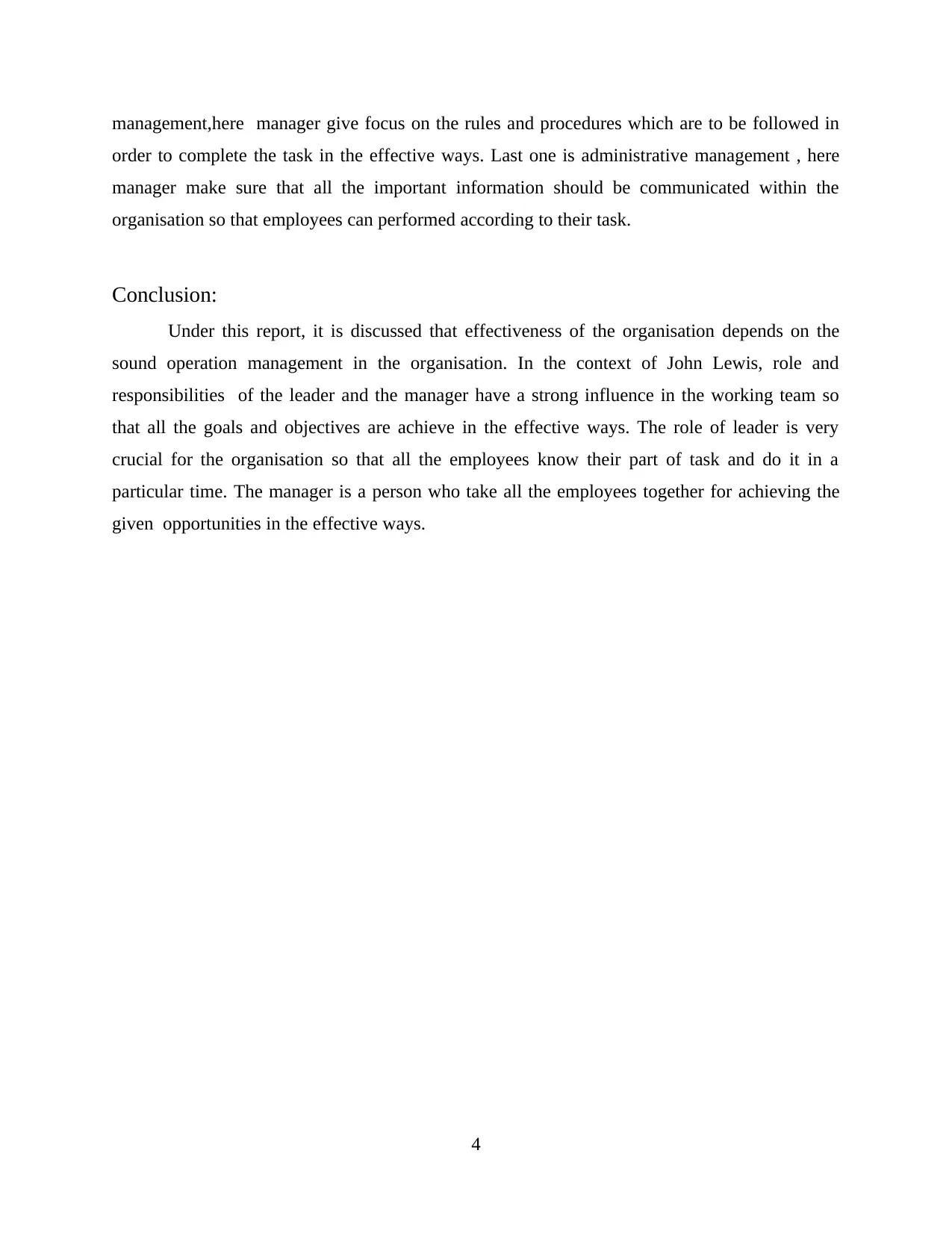
management,here manager give focus on the rules and procedures which are to be followed in
order to complete the task in the effective ways. Last one is administrative management , here
manager make sure that all the important information should be communicated within the
organisation so that employees can performed according to their task.
Conclusion:
Under this report, it is discussed that effectiveness of the organisation depends on the
sound operation management in the organisation. In the context of John Lewis, role and
responsibilities of the leader and the manager have a strong influence in the working team so
that all the goals and objectives are achieve in the effective ways. The role of leader is very
crucial for the organisation so that all the employees know their part of task and do it in a
particular time. The manager is a person who take all the employees together for achieving the
given opportunities in the effective ways.
4
order to complete the task in the effective ways. Last one is administrative management , here
manager make sure that all the important information should be communicated within the
organisation so that employees can performed according to their task.
Conclusion:
Under this report, it is discussed that effectiveness of the organisation depends on the
sound operation management in the organisation. In the context of John Lewis, role and
responsibilities of the leader and the manager have a strong influence in the working team so
that all the goals and objectives are achieve in the effective ways. The role of leader is very
crucial for the organisation so that all the employees know their part of task and do it in a
particular time. The manager is a person who take all the employees together for achieving the
given opportunities in the effective ways.
4
⊘ This is a preview!⊘
Do you want full access?
Subscribe today to unlock all pages.

Trusted by 1+ million students worldwide
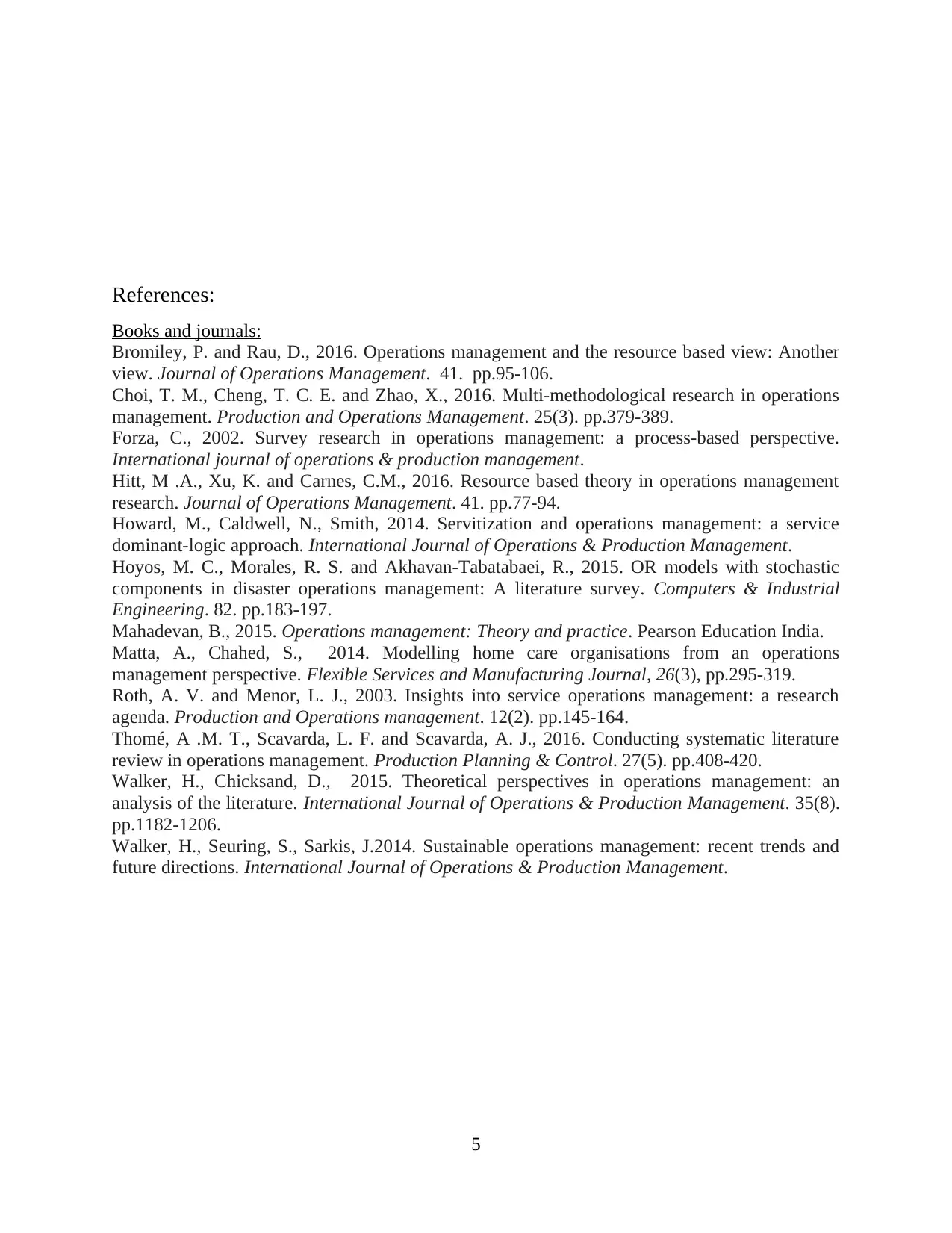
References:
Books and journals:
Bromiley, P. and Rau, D., 2016. Operations management and the resource based view: Another
view. Journal of Operations Management. 41. pp.95-106.
Choi, T. M., Cheng, T. C. E. and Zhao, X., 2016. Multi‐methodological research in operations
management. Production and Operations Management. 25(3). pp.379-389.
Forza, C., 2002. Survey research in operations management: a process‐based perspective.
International journal of operations & production management.
Hitt, M .A., Xu, K. and Carnes, C.M., 2016. Resource based theory in operations management
research. Journal of Operations Management. 41. pp.77-94.
Howard, M., Caldwell, N., Smith, 2014. Servitization and operations management: a service
dominant-logic approach. International Journal of Operations & Production Management.
Hoyos, M. C., Morales, R. S. and Akhavan-Tabatabaei, R., 2015. OR models with stochastic
components in disaster operations management: A literature survey. Computers & Industrial
Engineering. 82. pp.183-197.
Mahadevan, B., 2015. Operations management: Theory and practice. Pearson Education India.
Matta, A., Chahed, S., 2014. Modelling home care organisations from an operations
management perspective. Flexible Services and Manufacturing Journal, 26(3), pp.295-319.
Roth, A. V. and Menor, L. J., 2003. Insights into service operations management: a research
agenda. Production and Operations management. 12(2). pp.145-164.
Thomé, A .M. T., Scavarda, L. F. and Scavarda, A. J., 2016. Conducting systematic literature
review in operations management. Production Planning & Control. 27(5). pp.408-420.
Walker, H., Chicksand, D., 2015. Theoretical perspectives in operations management: an
analysis of the literature. International Journal of Operations & Production Management. 35(8).
pp.1182-1206.
Walker, H., Seuring, S., Sarkis, J.2014. Sustainable operations management: recent trends and
future directions. International Journal of Operations & Production Management.
5
Books and journals:
Bromiley, P. and Rau, D., 2016. Operations management and the resource based view: Another
view. Journal of Operations Management. 41. pp.95-106.
Choi, T. M., Cheng, T. C. E. and Zhao, X., 2016. Multi‐methodological research in operations
management. Production and Operations Management. 25(3). pp.379-389.
Forza, C., 2002. Survey research in operations management: a process‐based perspective.
International journal of operations & production management.
Hitt, M .A., Xu, K. and Carnes, C.M., 2016. Resource based theory in operations management
research. Journal of Operations Management. 41. pp.77-94.
Howard, M., Caldwell, N., Smith, 2014. Servitization and operations management: a service
dominant-logic approach. International Journal of Operations & Production Management.
Hoyos, M. C., Morales, R. S. and Akhavan-Tabatabaei, R., 2015. OR models with stochastic
components in disaster operations management: A literature survey. Computers & Industrial
Engineering. 82. pp.183-197.
Mahadevan, B., 2015. Operations management: Theory and practice. Pearson Education India.
Matta, A., Chahed, S., 2014. Modelling home care organisations from an operations
management perspective. Flexible Services and Manufacturing Journal, 26(3), pp.295-319.
Roth, A. V. and Menor, L. J., 2003. Insights into service operations management: a research
agenda. Production and Operations management. 12(2). pp.145-164.
Thomé, A .M. T., Scavarda, L. F. and Scavarda, A. J., 2016. Conducting systematic literature
review in operations management. Production Planning & Control. 27(5). pp.408-420.
Walker, H., Chicksand, D., 2015. Theoretical perspectives in operations management: an
analysis of the literature. International Journal of Operations & Production Management. 35(8).
pp.1182-1206.
Walker, H., Seuring, S., Sarkis, J.2014. Sustainable operations management: recent trends and
future directions. International Journal of Operations & Production Management.
5
1 out of 7
Related Documents
Your All-in-One AI-Powered Toolkit for Academic Success.
+13062052269
info@desklib.com
Available 24*7 on WhatsApp / Email
![[object Object]](/_next/static/media/star-bottom.7253800d.svg)
Unlock your academic potential
Copyright © 2020–2025 A2Z Services. All Rights Reserved. Developed and managed by ZUCOL.





